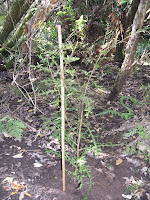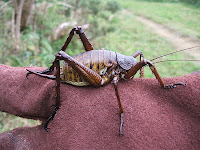
We have finally got all 13 of our rat bait stations installed. The map shows the approximate location of each.
Some are really remote but numbers 8 and 5 are just off the track. Ditrac is the name of the pellets we are using. They do not pose a danger to anything that may eat a poisoned mouse or rat. We record the number of pellets we add to each station. It is quite apparent that bait stations in some locations are being frequented by rats a lot more than other locations.

The bait stations have all been painted dark green so they are less likely to be seen and tampered with by the public.










 During one of our storms last month a Kanuka, down from the walk bridge, was blown over. When cutting it up for removal (firewood) it was noticed that there was a large Weta hole in the trunk. That section was kept aside and made into a Weta hotel. The Weta was coaxed out with a piece of apple as a lure, stored among forest litter in a shoe box while the trunk was converted, then reintroduced and installed back onto a tree in the gully.
During one of our storms last month a Kanuka, down from the walk bridge, was blown over. When cutting it up for removal (firewood) it was noticed that there was a large Weta hole in the trunk. That section was kept aside and made into a Weta hotel. The Weta was coaxed out with a piece of apple as a lure, stored among forest litter in a shoe box while the trunk was converted, then reintroduced and installed back onto a tree in the gully.

 Yes it has been a month of building accommodation for our fauna. On advice from Waikato Regional Council Fish Scientist we have started installing accommodation to attract more native fish to our stream. Four concrete block hotels were installed in ponds in the gully behind Sexton Road. The target fish are Giant and Banded Kokopu.
Yes it has been a month of building accommodation for our fauna. On advice from Waikato Regional Council Fish Scientist we have started installing accommodation to attract more native fish to our stream. Four concrete block hotels were installed in ponds in the gully behind Sexton Road. The target fish are Giant and Banded Kokopu.